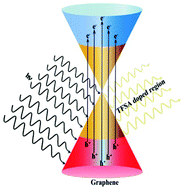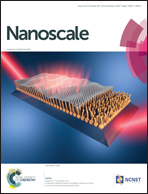Determining the Fermi level by absorption quenching of monolayer graphene by charge transfer doping†
Abstract
While optical properties of graphene in the visible region are solely defined by the frequency-independent fine structure constant, an onset of absorption has been observed in the infrared region due to Pauli blocking of interband transitions. Here, we report a complete absorption quenching in the infrared region by coating graphene with bis(trifluoromethanesulfonyl)amine (TFSA), an optically transparent p-type chemical dopant. The Fermi level downshift due to TFSA doping results in enhanced transmission in the infrared region proportional to the doping concentration. An absorption quenching onset method, developed in our work, to extract the Fermi level shift in pristine and doped graphene agrees with values extracted from Raman G-band and 2D-band shifts, Hall measurements and the binding energy shift observed in X-ray photo-electron spectroscopy. Performing simple UV-visible transmittance spectroscopy to obtain the absorption quenching onset of graphene also allows detection of environmental and substrate effects via Fermi level shift. Our method opens up the practical implementation of this unique phenomenon of graphene in future optoelectronic devices.


 Please wait while we load your content...
Please wait while we load your content...